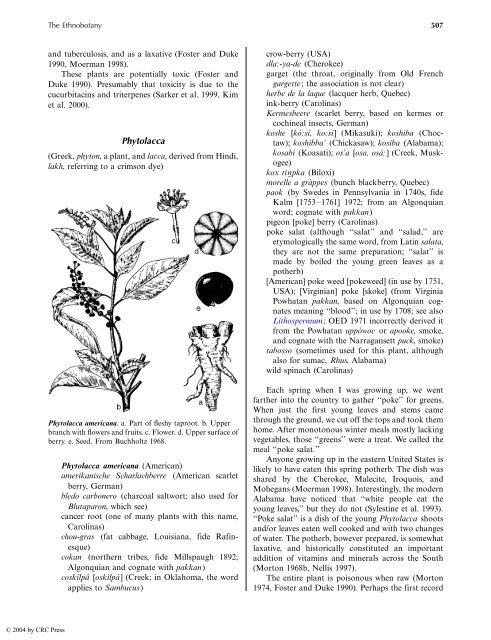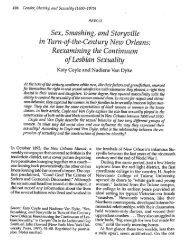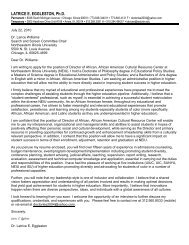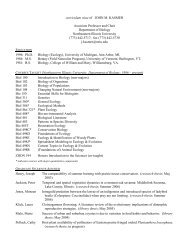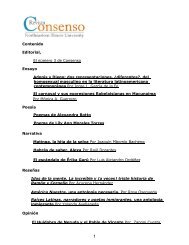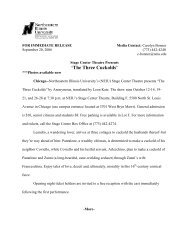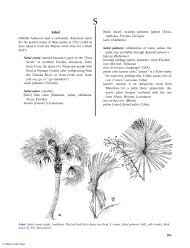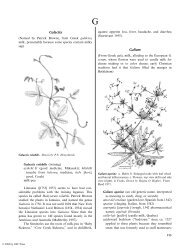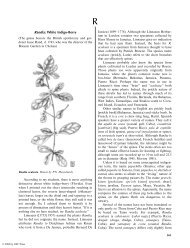Herba Cana - Northeastern Illinois University
Herba Cana - Northeastern Illinois University
Herba Cana - Northeastern Illinois University
Create successful ePaper yourself
Turn your PDF publications into a flip-book with our unique Google optimized e-Paper software.
© 2004 by CRC Press<br />
The Ethnobotany 507<br />
and tuberculosis, and as a laxative (Foster and Duke<br />
1990, Moerman 1998).<br />
These plants are potentially toxic (Foster and<br />
Duke 1990). Presumably that toxicity is due to the<br />
cucurbitacins and triterpenes (Sarker et al. 1999, Kim<br />
et al. 2000).<br />
Phytolacca<br />
(Greek, phyton, a plant, and lacca, derived from Hindi,<br />
lakh, referring to a crimson dye)<br />
Phytolacca americana. a. Part of fleshy taproot. b. Upper<br />
branch with flowers and fruits. c. Flower. d. Upper surface of<br />
berry. e. Seed. From Buchholtz 1968.<br />
Phytolacca americana (American)<br />
amerikanische Scharlachberre (American scarlet<br />
berry, German)<br />
bledo carbonero (charcoal saltwort; also used for<br />
Blutaparon, which see)<br />
cancer root (one of many plants with this name,<br />
Carolinas)<br />
chou-gras (fat cabbage, Louisiana, fide Rafinesque)<br />
cokan (northern tribes, fide Millspaugh 1892;<br />
Algonquian and cognate with pakkan)<br />
coskîlpâ [oskílpá] (Creek; in Oklahoma, the word<br />
applies to Sambucus)<br />
crow-berry (USA)<br />
dla:-ya-de (Cherokee)<br />
garget (the throat, originally from Old French<br />
gargette; the association is not clear)<br />
herbe de la laque (lacquer herb, Quebec)<br />
ink-berry (Carolinas)<br />
Kermesbeere (scarlet berry, based on kermes or<br />
cochineal insects, German)<br />
koshe [kó:sî, ko:si] (Mikasuki); koshiba (Choctaw);<br />
koshibba’ (Chickasaw); kosiba (Alabama);<br />
kosabí (Koasati); os’a [osa, osá:] (Creek, Muskogee)<br />
kox tinpka (Biloxi)<br />
morelle a gràppes (bunch blackberry, Quebec)<br />
paok (by Swedes in Pennsylvania in 1740s, fide<br />
Kalm [1753 /1761] 1972; from an Algonquian<br />
word; cognate with pakkan)<br />
pigeon [poke] berry (Carolinas)<br />
poke salat (although ‘‘salat’’ and ‘‘salad,’’ are<br />
etymologically the same word, from Latin salata,<br />
they are not the same preparation; ‘‘salat’’ is<br />
made by boiled the young green leaves as a<br />
potherb)<br />
[American] poke weed [pokeweed] (in use by 1751,<br />
USA); [Virginian] poke [skoke] (from Virginia<br />
Powhatan pakkan, based on Algonquian cognates<br />
meaning ‘‘blood’’; in use by 1708; see also<br />
Lithospermum; OED 1971 incorrectly derived it<br />
from the Powhatan uppówoc or apooke, smoke,<br />
and cognate with the Narragansett puck, smoke)<br />
tabosso (sometimes used for this plant, although<br />
also for sumac, Rhus, Alabama)<br />
wild spinach (Carolinas)<br />
Each spring when I was growing up, we went<br />
farther into the country to gather ‘‘poke’’ for greens.<br />
When just the first young leaves and stems came<br />
through the ground, we cut off the tops and took them<br />
home. After monotonous winter meals mostly lacking<br />
vegetables, those ‘‘greens’’ were a treat. We called the<br />
meal ‘‘poke salat.’’<br />
Anyone growing up in the eastern United States is<br />
likely to have eaten this spring potherb. The dish was<br />
shared by the Cherokee, Malecite, Iroquois, and<br />
Mohegans (Moerman 1998). Interestingly, the modern<br />
Alabama have noticed that ‘‘white people eat the<br />
young leaves,’’ but they do not (Sylestine et al. 1993).<br />
‘‘Poke salat’’ is a dish of the young Phytolacca shoots<br />
and/or leaves eaten well cooked and with two changes<br />
of water. The potherb, however prepared, is somewhat<br />
laxative, and historically constituted an important<br />
addition of vitamins and minerals across the South<br />
(Morton 1968b, Nellis 1997).<br />
The entire plant is poisonous when raw (Morton<br />
1974, Foster and Duke 1990). Perhaps the first record


